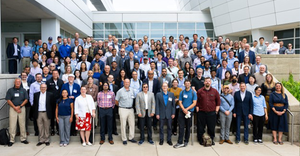An Idea Worth Recycling
December 1, 1998
Michael Fickes
As the public and private sectors compete nationwide, one four-year-old material recovery facility (MRF) in suburban Detroit is serving as a model of how cooperation between governments and private industry can achieve waste management goals - and save money.
Although the Resource Recovery and Recycling Authority of Southwest Oakland County (RRRASOC) and Houston-based Waste Management Inc. (WMI) enjoy a symbiotic relationship, each had its own agenda for sharing in the MRF's development, financing and operation when they inked the agreement in 1993:
* RRRASOC, a joint governmental authority formed in the late 1980s to manage solid waste issues for eight communities spanning 140 square miles, sought to divert a portion of the regional waste stream.
* WMI's business goals focused on using the MRF to increase the volumes that WMI's regional commodity sales group can offer to recycled materials buyers across the country's north central region. As the MRF's operator, WMI would be free to use the lion's share of the facility's capacity to pursue these recycling opportunities.
According to Michael J. Csapo, RRRASOC's general manager, the agreement called for WMI to:
* finance RRRASOC's purchase of the $1.4 million site;
* design, finance and construct the $5.6 million MRF after demolishing existing structures and remediating the site;
* operate and maintain the MRF for 15 years;
* provide participating RRRASOC municipalities with an option to enter into a collection, hauling and disposal contract for either 5- or 15-year terms; and
* assume the risk of marketing the recycled materials.
In turn, RRRASOC agreed to purchase the property, lease it to WMI for $1 per year and pay for 20 percent of the facility's cost.
When the contract ends, RRRASOC will own the property and 100 percent of the facility, despite the fact that it only paid 20 percent of the facility's cost.
The plan works because the recyclable materials flowing into the plant from the RRRASOC region comprise only 20 percent of the MRF's processing capacity. WMI can fill up the plant's remaining 80 percent of capacity by accepting material from its own recycling collection operations and from third-party haulers.
Under the contract, RRRASOC receives certain revenues, including a host fee of 50 cents per ton and a share of WMI's sales when prices exceed targets specified in the contract. The targets are set to insure that WMI covers its operating costs before beginning to share revenues.
RRRASOC pays for its share of the project through a MRF service fee of 77 cents per month per household. The money comes out of a blended fee for refuse and recycling collection, hauling and disposal paid by RRRASOC member communities - a plan that eliminates the need to charge facility tipping fees for participating member communities.
Another key part of the contract requires that WMI markets all materials, except residuals and contaminants, even when low prices make it more economical to landfill the materials. "That's important to our mission of reducing the waste stream," Csapo says. "Landfilling undermines that goal."
Of course, there are exceptions to the rule. Should conditions temporarily prevent WMI from finding a market for certain materials, RRRASOC will permit the company to landfill those materials.
This unusual plan has worked well enough to earn RRRASOC a Public-Private Partnership award from the National Council for Public-Private Partnerships in 1995, the first year of the plant's operation.
Breaking Ground RRRASOC found the perfect site for the MRF in the city of Southfield, Mich., which is located on the eastern edge of the eight-city region. The six-acre location was a contaminated industrial site with a number of dilapidated buildings.
"The cooperation of Southfield and our initiative with WMI enabled us to clean up the site and reuse a contaminated piece of property," Csapo says.
The MRF encompasses 45,000 square feet and operates two processing lines: one for paper, the other for co-mingled containers. Overall, the facility can process 200 tons of material per eight-hour shift. It currently operates two shifts, 6 a.m. to 3 p.m. and 3 p.m. to 11 p.m., five days a week.
Under the agreement between RRRASOC and Waste Management, the facility can receive material 12 hours per day and operate at night, should business warrant.
When designing the MRF, WMI took a conservative approach, opting to stay away from unproved technology, but allowing for the addition of new equipment as it gains acceptance.
The facility's manual paper sorting line, supplied by Mayfran International, Cleveland, consists of five bunkers, one of which has a live bottom conveyor, a Mayfran 6-inch pitch hinged steel belt conveyer, that carries negatively sorted newspapers to a Harris baler.
The plant also ships some loose newspaper. To accommodate this, the line can reverse one of the last conveyors and divert the newspaper into a 12-yard compactor and transfer trailer.
On the sorting line, pickers separate brown bags, magazines, old corrugated cardboard (OCC) and other types of paper.
In 1993, during facility construction, RRRASOC and WMI considered installing automated corrugated sorting lines, but decided to wait.
Now, five years later, Chris Barbero, the facility's plant manager, is planning to install the automated line. "We've seen the equipment operating at other facilities," he says. "And we believe that it will increase our throughput rate and require fewer employees."
The co-mingled container line, from Des Moines, Iowa-based Countec Recycling Systems, processes approximately seven tons per hour. Once sorted, the material moves into a compactor with a 40-yard box.
At the end of the line is a Harris/ Selco baler with a bale separation door. Here, the operator uses a camera and monitor to see what is emptying onto the belts before baling.
Here, too, Barbero is refining the line. "We're gradually beefing up some of the mixed glass handling components with troughing idlers," he says.
What Goes In, What Comes Out Under the RRRASOC-WMI agreement, RRRASOC must supply a material base for the plant from no less than 40,000 single-family units.
"We calculated that this would constitute between 15 percent and 20 percent of plant volume, and that's proving out," Csapo says. WMI can bring in as much additional volume as it wants to, as long as it doesn't displace our volume."
With a population of 250,000 residents, RRRASOC's region easily meets its material supply obligations.
"We have signed MRF service agreements with five of the eight communities in our region," Csapo explains. "Under these agreements, the communities commit to send materials to the MRF regardless of the collection arrangements. We also receive material from two subscription communities in our area."
Of the remaining three RRRASOC communities, one deals with a hauler that takes materials to its own MRF; and two are subscription communities with no control over where recyclables are taken.
Additional material arrives by way of three drop-off centers located across the region. One of these drop-off centers is located at the MRF itself.
WMI brings in much of its own material from curbside recycling collection programs that serve more than 200,000 households in the Detroit metropolitan area.
"The facility also takes in material from a small number of third-party haulers," Barbero says, but notes that this doesn't amount to more than a couple hundred tons per month.
However, that amount all adds up. According to RRRASOC's 1997 annual report, the MRF has increased recycled tonnages by substantial amounts every year since 1995.
In 1995, the first year of operation, the facility processed approximately 39,000 tons. In 1996, the volume rose to 42,000 tons. During 1997, the MRF posted a 29 percent increase and processed nearly 54,000 tons. Of the 1997 total, 9,000 tons, or 17 percent, came from RRRASOC member community programs.
Old newsprint (ONP) has become the MRF's staple, constituting 48 percent, or 26,000 tons, of the total material shipped in 1997. OCC comprises 21 percent of the total. Other paper provided about 7 percent of the plant's work.
The plant's co-mingled container side accounted for 16 percent of the shipped material, and glass accounted for 5,000 tons, or 60 percent, of that segment. Miscellaneous items such as polystyrene, carpeting and waste comprised 8 percent, or 4,450 tons, of the facility's output.
The 1998 totals promise to show even more growth. Houston-based USA Waste's acquisition of WMI during the summer immediately increased the materials passing through the MRF from approximately 4,500 tons per month to nearly 6,000 tons per month, Barbero says.
Barbero has extended the plant's operating hours to accommodate this additional material. "We now have two shifts on the fiber line and one shift on the container line," he says.
According to Csapo, the MRF is on track to process a total of 65,000 tons during 1998 - approximately 15 percent of which will originate from RRRASOC communities.
After four years of operation, the MRF has produced on both WMI's and RRRASOC's agendas. Barbero reports no problems related to marketing the commodities. "We sell a portion of the material under contracts," he says. "We also sell on the basis of traditional handshake agreements that have been in place for years."
In addition, the MRF contributes volume to regional sales efforts handled out of the company's commodity marketing center in Chicago. "While some of our sales contracts are specific to this location, they often are larger contracts that are filled with material from multiple shipping points," Barbero says.
Csapo reports that the MRF also is helping RRRASOC achieve its diversion goals. "The Authority operates a scale house on the MRF's back lot, which gives us control over incoming materials and enables us to measure diversion rates," he says. "In the past, we got information about recycling volumes from various haulers, but it was spotty. Thanks to the MRF, we can generate reliable data and use it to set realistic goals.
"According to the data we have collected, we have increased diversion through recycling by 10.7 percent in the communities we serve," Csapo continues. "This includes a reduction in household wastes, which we attribute to our overall education campaign."
Csapo does not believe the RRRASOC-WMI approach to financing, building and operating this MRF has been copied by other waste management authorities and companies. Nevertheless, the success of the idea has strengthened his belief in public-private cooperation.
"Regional authorities don't have to compete with private industries," Csapo says. "Private companies are good at operations. Governments are good at setting policy and planning programs. Cooperation lets each side focus on what it is good at."
From that point of view, the idea may be worth recycling into other regions of the country.
Processing Equipment Mayfran fiber sort line; Countec co-mingled container sort line; HRB 918 baler; HRB 59N baler; miscellaneous rolling stock, compactors
Refuse Processed In September 1998, averaged approximately 260 tons/day incoming. Also shipped in excess of 6,000 tons outbound for the first month since opening the facility in November 1994.
Sources of Waste * 60 percent residential curbside and drop-off center material; 40 percent commercial/industrial loads, primarily old corrugated cardboard and office paper
* 90 percent of incoming waste is collected and delivered by Waste Management Inc. hauling operations
Employees * 15 full-time, permanent employees, including: office, supervisor, maintenance and equipment operators/lead sorters
* 18-20 outsourced employees (primarily sorters)
Service Area Detroit Metropolitan Area/S.E. Michigan
Factoid Recycle America employees have found everything in trash loads from an Italian sub-machine gun to $1,000 in cash.
You May Also Like


